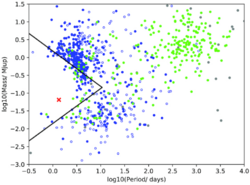Astronomy:Neptunian desert
The Neptunian desert or sub-Jovian desert is broadly defined as the region close to a star (period < 2–4 days) where no Neptune-sized ( > 0.1 |♃|J}}}}}}) exoplanets are found.[1] This zone receives strong irradiation from the star, meaning the planets cannot retain their gaseous atmospheres: They evaporate, leaving just a rocky core.[2]
Neptune-sized planets should be easier to find in short-period orbits, and many sufficiently massive planets have been discovered with longer orbits from surveys such as CoRoT and Kepler.[1] The physical mechanisms that result in the observed Neptunian desert are currently unknown, but have been suggested to be due to a different formation mechanism for short-period super-Earth and Jovian exoplanets, similar to the reasons for the brown-dwarf desert.[1]
Candidates
NGTS-4b
The exoplanet NGTS-4b, with mass of 20 M⊕, and a radius 20% smaller than Neptune, was found to still have an atmosphere while orbiting every 1.3 days within the Neptunian desert of NGTS-4, a K-dwarf star located 922 light-years from Earth.[2] The atmosphere may have survived due to the planet's unusually high core mass, or it might have migrated to its current close-in orbit after this epoch of maximum stellar activity.[1]
LTT 9779 b
LTT 9779 b is an ultra-hot Neptune in the Neptunian desert. It has an unusually high albedo of 0.8, and likely has a metal-rich atmosphere.[3]
See also
Notes
- ↑ 1.0 1.1 1.2 1.3 Watson, Christopher A.; Walker, Simon R.; Udry, Stéphane; Thompson, Samantha J.; Sohy, Sandrine; Rauer, Heike et al. (2019-07-11). "NGTS-4b: A sub-Neptune transiting in the desert". Monthly Notices of the Royal Astronomical Society 486 (4): 5094–5103. doi:10.1093/mnras/stz1084. ISSN 0035-8711. Bibcode: 2019MNRAS.486.5094W.
- ↑ 2.0 2.1 "The 'Forbidden' planet has been found in the 'Neptunian Desert'". University of Warwick. 29 May 2019. https://phys.org/news/2019-05-forbidden-planet-neptunian.html.
- ↑ Jenkins, James S. et al. (September 2020). "An Ultra-Hot Neptune in the Neptune desert". Nature Astronomy 4 (12): 1148–1157. doi:10.1038/s41550-020-1142-z. Bibcode: 2020NatAs...4.1148J.
 |



